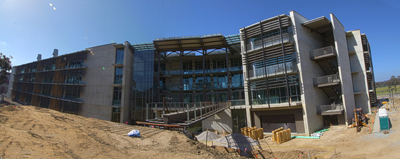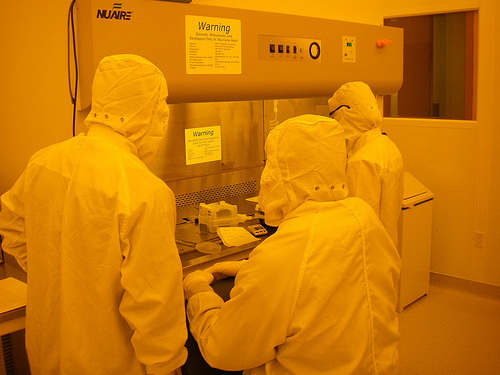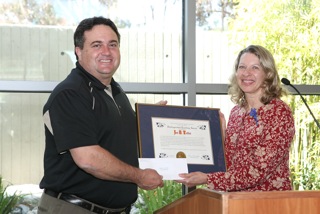NanoEngineering to Maintain Calit2 Links While Preparing to Move into New Headquarters Nearby
San Diego, June 8, 2012 --At the UCSD Division’s regular Executive Council meeting on June 7, NanoEngineering chair Ken Vecchio briefed Calit2 faculty and staffers on current plans for moving most of his Department’s facilities out of Atkinson Hall after two years calling Calit2 home.
|
“Professor Joe Wang’s lab will probably be the first to be moved,” said Vecchio, “but we also will be moving lab facilities from several other buildings on campus. My own lab will probably be the last to be relocated.”
Vecchio says Calit2 played an important role in getting the Department of NanoEngineering from its creation to a headquarters of its own in the new building.
“In the past two years we were able to house all of our faculty, who came from different departments, here at Calit2, which was critical to forging collaborative links between researchers,” he said. “It was especially important for our young faculty, and I’m happy to report that today every member of the faculty now has multiple research contracts, which is rare with so many young faculty in a new field.”
|
Thanks to their residence in Atkinson Hall, a number of NanoEngineering researchers have now developed contacts and collaborations with other Calit2 residents, and they are expected to continue as academic participants in the institute. Joe Wang, for one, is expected to continue as a member of the peer-review committee for the Calit2 Strategic Research Opportunities (CSRO) grant program as it launches its second solicitation for grant proposals this summer. NanoEngineering faculty will also be eligible to apply for funding under that program, which provides a mix of cash and in-kind services for one-year projects that are consistent with Calit2’s application thrusts in health, energy, the environment, and culture, as well as wireless, photonics, cyberinfrastructure as well as nano-micro-electro-mechanical systems (nano-MEMS).
|
During its two-plus years in Atkinson Hall, the department has witnessed an explosion in interest and student enrollment. NanoEngineering is now the home department of 550 undergrads and 100 graduate students and postdoctoral researchers.
Increased enrollments will be taxing on NanoEngineering faculty, who currently number 10 full professors, one associate professor, and six assistant professors. The department is losing one of its most popular young faculty members, Jennifer Cha, to the University of Colorado, Boulder, as well as one of its most senior faculty, Pao Chau, who is retiring. On the other hand, the department is in the process of hiring a Lecturer in Chemical Engineering to take up some of the teaching load, as well as an assistant professor specializing in solar materials and flexible electronics, and a full professor with strong experience in materials science research related to energy technologies, specifically battery technologies and materials in extreme environment.
“Many of our faculty will have to take on more responsibilities to accommodate rising enrollments,” admits Vecchio. “But I am sure they will rise to the occasion.”
|
The new $82 million Structural and Materials Engineering Building has been a long time coming. The campus broke ground on the five-story building (including basement) in November 2008. The building has 110,000 assignable square feet, and will include over 70 individual engineering labs, offices, a conference center, visual-arts studios, and a high-bay fabrication suite. It will house the headquarters for the Department of Structural Engineering in addition to NanoEngineering, as well as parts of the Visual Arts department.
NanoEngineering will occupy the entire second floor, but will also have three labs on the third floor, one lab for its undergraduate NanoEngineering senior capstone courses on the first floor, as well as establishing a major shared-use facility in the basement called the NanoEngineering Materials Research Center (NE-MRC). This center will house an array of equipment and instruments covering a broad spectrum of materials characterization, synthesis, and testing capabilities – and it was designed to augment and complement the Nano3 nanofabrication facility at Calit2.
Related Links
UCSD Department of NanoEngineering
Nano3
Media Contacts
Doug Ramsey, 858-822-5825, dramsey@ucsd.edu




